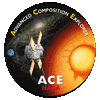

ACE/SIS-CRIS Level 3 Summary Plots
SIS Charge (Z) vs time Plots
SIS Charge (Z) vs time Plots
-
These plots show the calculated nuclear charge Z as a function
of detection time for each pulseheight-analyzed particle recorded
by SIS. Standard data cuts were applied requiring that
particles stop in the instrument and that multiple calculations
of Z using different combinations of energy-loss measurements
be consistent in order to reject interacting particles and/or
chance coincidences of multiple particles. Time periods for
each plot are on Bartels rotation boundaries, and each time
period is represented by 4 plots, covering SIS ranges 0, 1,
2 & 3, and 4-7. This corresponds to a different energy interval
for each element. For oxygen, the plots approximately represent
7.1-10.0, 10.0-13.1, 13.1-21.0, and 21.0-89.8 MeV/nucleon, while
for iron the intervals are approximately 10.5-15.8, 15.8-21.5,
21.5-36.3, and 36.3-167.7 MeV/nucleon; see
here
for corresponding energy intervals of other abundant elements.
The purpose of these plots is to quickly determine periods which are interesting from a compositional standpoint, for example periods which are particularly iron-rich at high energies, or which had large measureable abundances of relatively rare species such as odd-Z elements or ultraheavy (Z>28) nuclei. Note that individual pulse height events have been plotted and there has been no correction for instrument livetime, thus absolute intensities cannot be determined from these plots; see SIS level 2 data for corrected absolute intensities of abundant elements. The lack of livetime correction can lead to some unusual artifacts during intense solar particle events; during the most extreme cases (such as the 14 July 2000 Bastille Day event) the density of plotted points actually drops at the peak of the event due to the greatly diminished livetime. Also, at all periods, helium (Z=2) is deliberately throttled by the instrument, resulting in a much lower density of points than would otherwise be the case. Finally, in spite of the data cuts, some background events and artifacts still remain, especially at low ranges (range 0 and range 1) at low Z (near He), where spurious tracks near Li (Z=3) sometimes appear.
SIS/CRIS Count-rate Plots
-
These data consist of 4 SIS rates and 1 CRIS rate (in counts/second)
versus time, with one month of data per plot. Since the data are given
in counts/second, the energy intervals and geometry factors must be
corrected for before obtaining meaningful abundance ratios from these
data. The data are derived from SIS and CRIS level 1 rate data and are
an improvement over the Browse data, in that sensor priority schemes
have been corrected for. However, the data still contain a certain
amount of background (especially the T4 and He SIS rates) which have not
been corrected for.
- T4 - the singles rate for detector T4, this rate is primarily protons of energies > 10 MeV (also used in the ACE RTSW plots).
- He - the He buffer rate for ranges 0-2, corresponding to ~4-7 MeV/nucleon.
- CNO - the CNO buffer rate for ranges 0-2, corresponding to ~7-15 MeV/nucleon.
- Ne-Fe - the Z >= 10 buffer rate for ranges 0-2, corresponding to ~9-20 MeV/nucleon.
- the weighted average of the Z >= 10 buffer rates for ranges 3-4, 5-7, and 8, corresponding to ~100-400 MeV/nucleon. This data is generally not available during high rate time periods.
The 4 SIS rates are as follows:
The CRIS rate is:
These plots are for browse purposes only and are not suitable for serious scientific study. For that you should use ACE Level 2 data.
These files can be downloaded via anonymous ftp, from mussel.srl.caltech.edu in the directory:
pub/ace/level3/sis/counts and pub/ace/level3/sis/zvst